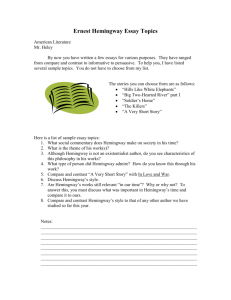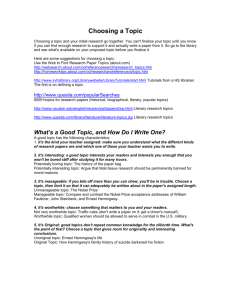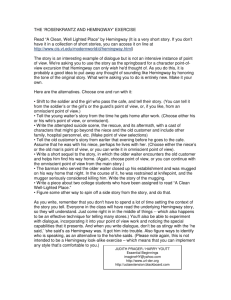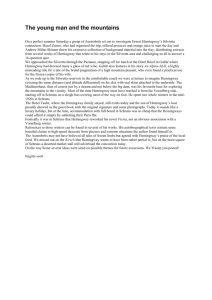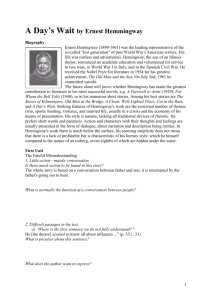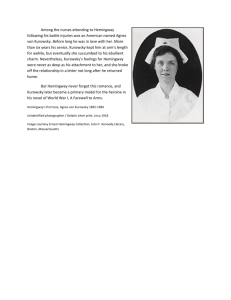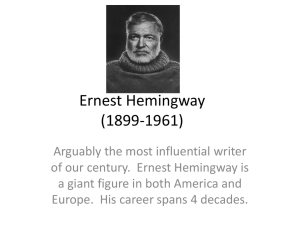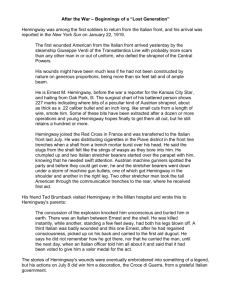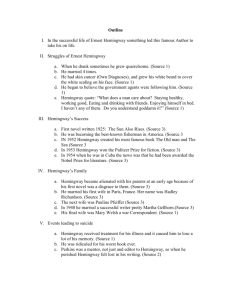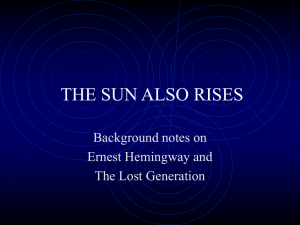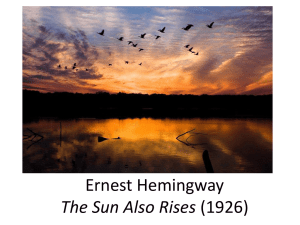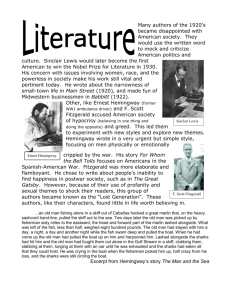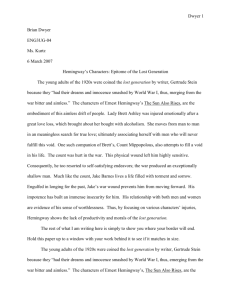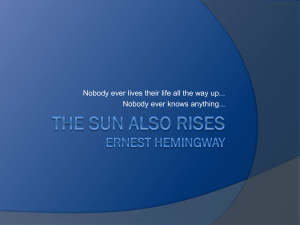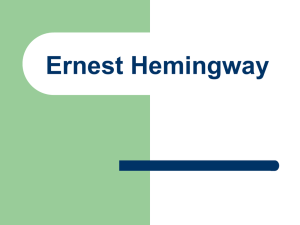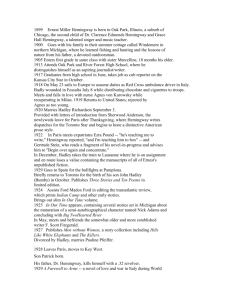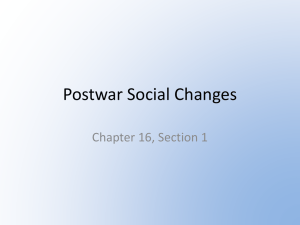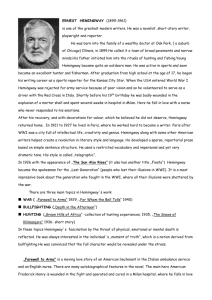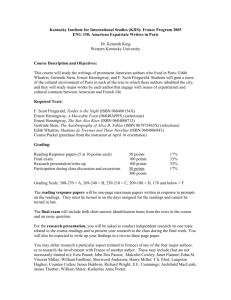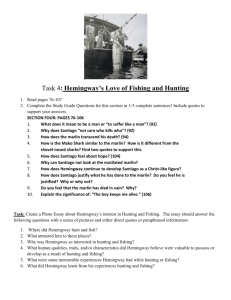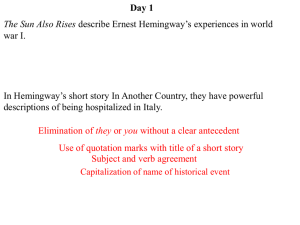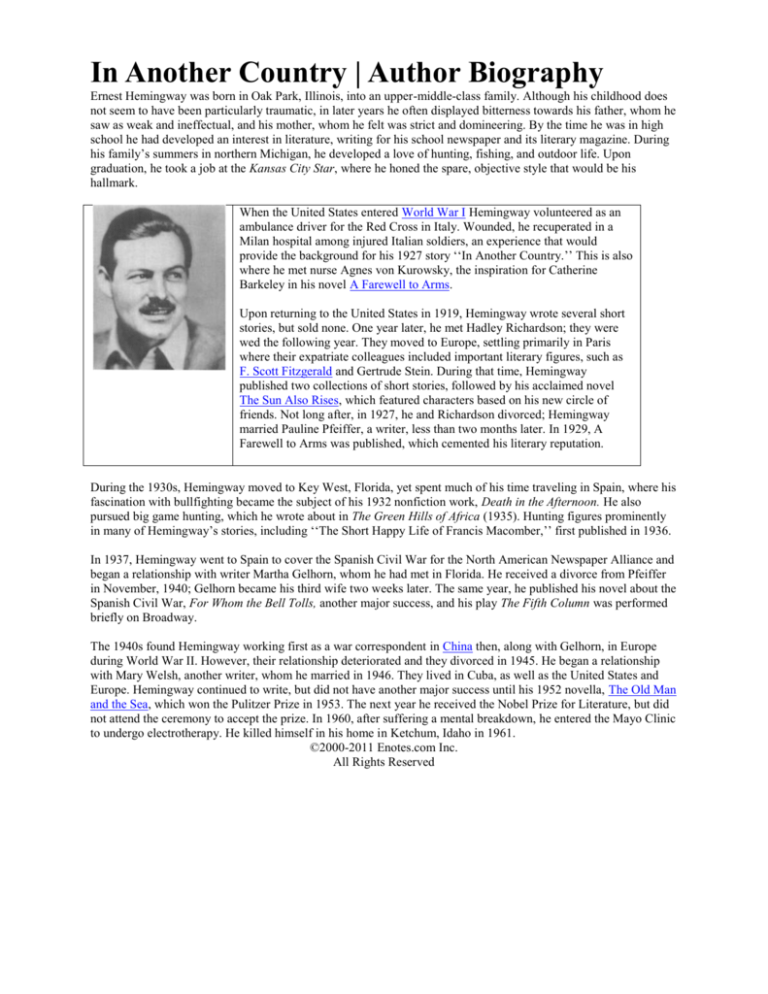
In Another Country | Author Biography
Ernest Hemingway was born in Oak Park, Illinois, into an upper-middle-class family. Although his childhood does
not seem to have been particularly traumatic, in later years he often displayed bitterness towards his father, whom he
saw as weak and ineffectual, and his mother, whom he felt was strict and domineering. By the time he was in high
school he had developed an interest in literature, writing for his school newspaper and its literary magazine. During
his family’s summers in northern Michigan, he developed a love of hunting, fishing, and outdoor life. Upon
graduation, he took a job at the Kansas City Star, where he honed the spare, objective style that would be his
hallmark.
When the United States entered World War I Hemingway volunteered as an
ambulance driver for the Red Cross in Italy. Wounded, he recuperated in a
Milan hospital among injured Italian soldiers, an experience that would
provide the background for his 1927 story ‘‘In Another Country.’’ This is also
where he met nurse Agnes von Kurowsky, the inspiration for Catherine
Barkeley in his novel A Farewell to Arms.
Upon returning to the United States in 1919, Hemingway wrote several short
stories, but sold none. One year later, he met Hadley Richardson; they were
wed the following year. They moved to Europe, settling primarily in Paris
where their expatriate colleagues included important literary figures, such as
F. Scott Fitzgerald and Gertrude Stein. During that time, Hemingway
published two collections of short stories, followed by his acclaimed novel
The Sun Also Rises, which featured characters based on his new circle of
friends. Not long after, in 1927, he and Richardson divorced; Hemingway
married Pauline Pfeiffer, a writer, less than two months later. In 1929, A
Farewell to Arms was published, which cemented his literary reputation.
During the 1930s, Hemingway moved to Key West, Florida, yet spent much of his time traveling in Spain, where his
fascination with bullfighting became the subject of his 1932 nonfiction work, Death in the Afternoon. He also
pursued big game hunting, which he wrote about in The Green Hills of Africa (1935). Hunting figures prominently
in many of Hemingway’s stories, including ‘‘The Short Happy Life of Francis Macomber,’’ first published in 1936.
In 1937, Hemingway went to Spain to cover the Spanish Civil War for the North American Newspaper Alliance and
began a relationship with writer Martha Gelhorn, whom he had met in Florida. He received a divorce from Pfeiffer
in November, 1940; Gelhorn became his third wife two weeks later. The same year, he published his novel about the
Spanish Civil War, For Whom the Bell Tolls, another major success, and his play The Fifth Column was performed
briefly on Broadway.
The 1940s found Hemingway working first as a war correspondent in China then, along with Gelhorn, in Europe
during World War II. However, their relationship deteriorated and they divorced in 1945. He began a relationship
with Mary Welsh, another writer, whom he married in 1946. They lived in Cuba, as well as the United States and
Europe. Hemingway continued to write, but did not have another major success until his 1952 novella, The Old Man
and the Sea, which won the Pulitzer Prize in 1953. The next year he received the Nobel Prize for Literature, but did
not attend the ceremony to accept the prize. In 1960, after suffering a mental breakdown, he entered the Mayo Clinic
to undergo electrotherapy. He killed himself in his home in Ketchum, Idaho in 1961.
©2000-2011 Enotes.com Inc.
All Rights Reserved
In Another Country – Analysis Worksheet
After reading, annotating, and defining unfamiliar words, discuss and take notes on the
following:
1. Compare and contrast the narrator, major, and three Milanese soldiers.
Narrator
Major
Three Milanese
soldiers
Similarities
Differences
2. What theme does the author explore regarding the idea of heroism?
3. What theme does the author explore regarding the consequences of WWI?
4. Why is it titled, “In Another Country”? Use examples for support.
5. What might the window symbolize? Use evidence to support your ideas.
6. What might the machines symbolize? Use evidence to support your ideas.
7. What is Hemingway’s tone or attitude in this story? List words and phrases (not
complete sentences) for support, and cite the page number.

